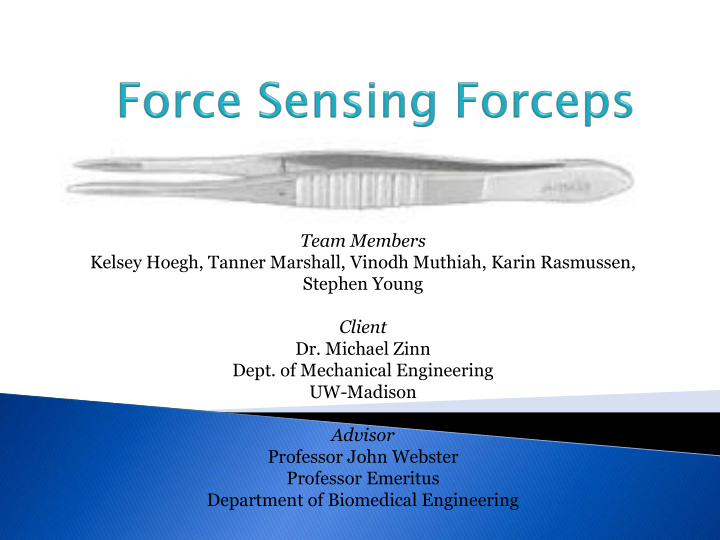



Team Members Kelsey Hoegh, Tanner Marshall, Vinodh Muthiah, Karin Rasmussen, Stephen Young Client Dr. Michael Zinn Dept. of Mechanical Engineering UW-Madison Advisor Professor John Webster Professor Emeritus Department of Biomedical Engineering
Background/Motivation Current Devices Problem Statement Client Specifications Design Option1 - Silicon Macro Force Sensor Caps Design Option 2 - Piezoelectric Sensors Design Option 3 - Strain Gages Design Matrix Future Work
Develop „force sensing forceps‟ Nothing, quantitatively , known about forces applied to tissues Currently based on “trial and error” Used as a training tool Visual or auditory cue
Similarities • Developed force sensing surgical instrument • Used piezo materials • Differences • Not specific to forceps • Focused on degradation of medical alloys
Similarities • Developed force sensing surgical instrument • Used strain gages • Design considerations • Differences • Specific to laparoscopy • Different type of forceps
Training and research device Interface with standard surgical forceps Measure forces Provide quantitative output Avoid hindrance to normal use of forceps
Requirements: ◦ Production of 1 initial working prototype ◦ Allow for normal use of surgical forceps Holding technique Lightweight Standard size forceps ◦ Sanitation ◦ Quantitative forces measurement Convenient output Calibration ◦ Bio Safe
Preferences ◦ Prevention of excessive force ◦ Aesthetically pleasing ◦ Wireless ◦ Digital display ◦ Axial and torsional measurements
Pros ◦ Takes force measurement directly at tips Cons ◦ Difficult to manufacture ◦ Requires many cap types ◦ Temperature sensitive
• Uses the charge retaining properties in certain solid materials • Measurable piezoelectricity is released upon deformation
Pros ◦ Can be effective when space is limited; strain gage transducer can be up to 30 times larger ◦ Two wires connecting sensor Cons • • Considerable drift is present, making them more short-term • Doesn‟t compensate for temperature effectively
Converts mechanical motion into electronic signal Uses metallic foil organized into grid like pattern Depends on proportional variance of electrical resistance to strain Full bridge configuration – uses a total of 4 strain gages
Pros: Cons: ◦ Using 4 strain gages ◦ 4 wires running down helps eliminate side of forceps temperature effects ◦ Need of calibration – ◦ Choose range/accuracy dependent on the stability easily of the stainless steel ◦ Easy to manufacture/low ◦ Will need assistance to cost (5 strain gage dual grids for 49$) mount strain gages onto forceps ◦ Light-weight
Design Capped Ends silicon Weighting Strain Gages Piezo electric macro force sensor Does not detract from function of 25 22 23 24 standard surgical forceps Range of force measuring 20 15 19 19 capability Does not obstruct proper forceps 10 10 10 10 holding technique Precision of measuring 20 15 18 16 capability Ease of 5 1 3 4 manufacture Measurement consistency with 20 15 19 12 varying conditions Total 100 78 92 84
Consult surgeons on typically applied loads Signal conditioning Build rough version of the forceps Test measurement accuracy under various conditions ◦ Experiment with sensor location Develop calibration technique
Make forceps wireless Audio/visual feedback for surgeon Measurement of force in multiple dimensions ◦ Requires more complicated sensor setup ◦ Measure push/pulling force ◦ Measure twisting force Compatibility with cauterization technique
Dr. Michael Zinn Carter Smith Professor Webster John Dreger
“ Load Sensing Surgical Instruments”, Jacq, Maeder, Ryser ” “ Development of Force Measurement System for Clinical Use in Minimal Access Surgery,” Hanna , Drew, Arnold, Fakhm, Cuschieri ”
Recommend
More recommend